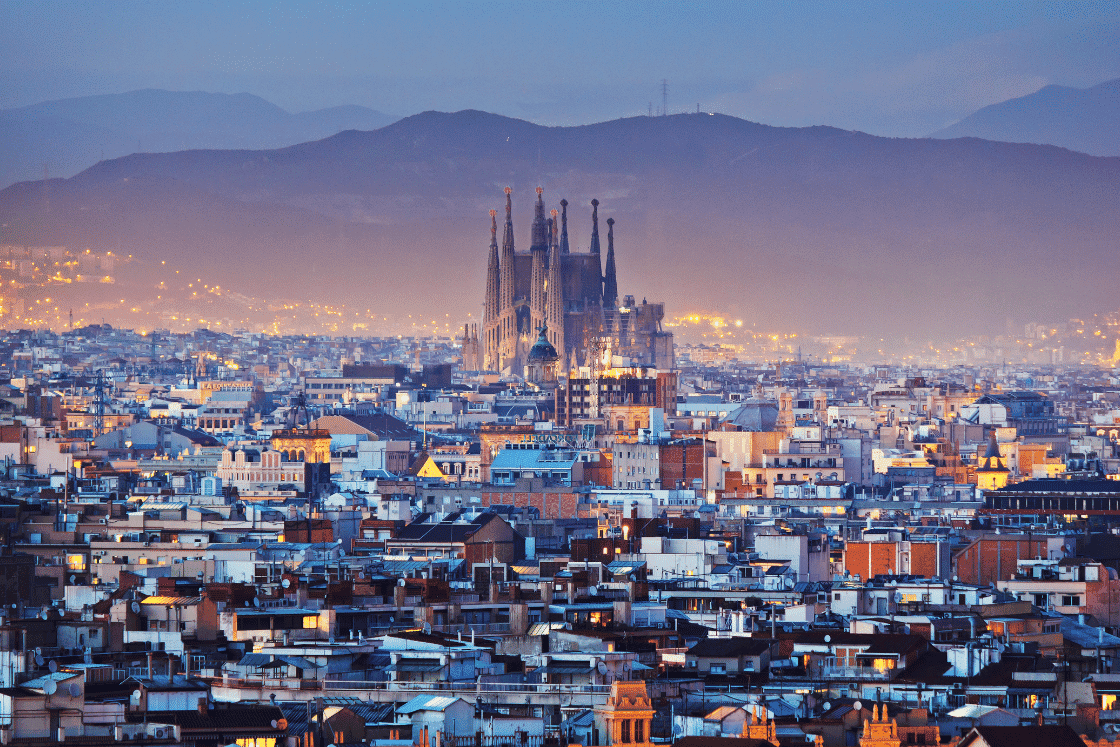Discover the vibrant heart of Catalonia, Barcelona, with Travels Jinn ultimate travel guide! This city is known for its unique blend of modernism and history. Nestled between the Mediterranean Sea and the Serra de Collserola mountains, Barcelona is a bustling metropolis filled with architectural marvels, rich cultural heritage, and a thriving arts scene. This dynamic city attracts millions of visitors each year, eager to experience its sunny beaches, world-renowned cuisine, and lively nightlife.
This guide will explore Barcelona’s top attractions, hidden gems, must-do activities, culinary delights, varied accommodations, and essential travel tips.
Plan and book your ultimate Barcelona adventure with Travels Jinn for exclusive opportunities and seamless experiences. Travels Jinn offers personalized itineraries, guides, translations and unbeatable discounts, making your trip planning effortless and enjoyable.
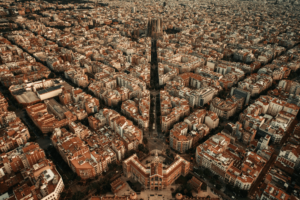
Historical Overview of Barcelona
Barcelona’s history is as rich and diverse as its architecture. Founded as a Roman city in the 1st century BC, it evolved into a significant medieval trade center and later became the capital of Catalonia. The city’s historical layers are evident in its architectural marvels, from ancient Roman walls to Gothic cathedrals and modernist masterpieces.
Key Historical Milestones of Barcelona
Roman Foundation (1st century BC): Barcelona, originally named Barcino, was founded as a Roman colony around 15 BC. It served as an important military and commercial center.
Muslim Invasion (8th century): In 711, Muslim forces invaded the Iberian Peninsula, including Barcelona, which remained under Muslim control until the early 9th century.
Frankish Control (801 AD): Louis the Pious, son of Charlemagne, recaptured Barcelona from the Moors, making it part of the Carolingian Empire and establishing it as a key city in the Spanish Marches.
Union with Catalonia (1137): Barcelona became the capital of the County of Barcelona, which was united with the Kingdom of Aragon through the marriage of Ramon Berenguer IV and Petronilla of Aragon, forming a powerful Mediterranean empire.
Catalan-Aragonese Empire (13th-15th centuries): Barcelona thrived as a major Mediterranean trading hub and cultural center, influencing territories across the Mediterranean.
Industrialization and Art Nouveau (19th century): Barcelona underwent significant industrialization, transforming into a modern metropolis. The late 19th century saw the rise of the Modernisme (Art Nouveau) movement, with architects like Antoni Gaudí leaving a lasting impact on the city’s architecture.
Spanish Civil War (1936-1939): Barcelona played a significant role in the Spanish Civil War, initially under Republican control before falling to Franco’s Nationalist forces in 1939.
Post-Franco Era and Democracy (1975 onwards): Following Franco’s death in 1975, Spain transitioned to democracy. Barcelona regained its status as a vibrant cultural and economic center.
1992 Summer Olympics: The Olympics brought significant urban renewal and international attention, transforming Barcelona into a major global city.
Modern Day: Barcelona continues to be a major cultural, economic, and tourist destination, known for its rich history, architecture, and vibrant culture.
Cultural and Architectural Legacy of Barcelona
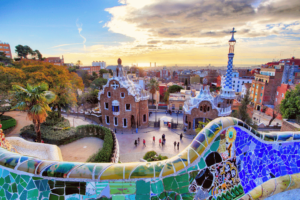
Barcelona’s architecture reflects its complex past, starting with the ancient Iberian settlers and continuing through Roman, Visigoth, and Islamic periods. This eclectic mix forms the foundation of Barcelona’s unique architectural landscape.
One of the most significant contributions to Barcelona’s architectural heritage is from the Modernisme movement in the late 19th and early 20th centuries. Architects like Antoni Gaudí, Lluís Domènech i Montaner, and Josep Puig i Cadafalch transformed the cityscape with their innovative designs. Gaudí’s masterpieces, including the Sagrada Família, Park Güell, and Casa Batlló, are quintessential examples of this style, characterized by organic shapes, vibrant colors, and intricate details.
The Gothic Quarter, or Barri Gòtic, is another testament to Barcelona’s architectural splendor. This area is filled with medieval buildings, narrow winding streets, and historic landmarks such as the Barcelona Cathedral. The Gothic style dominates this neighborhood, showcasing the city’s medieval roots.
Barcelona’s legacy is not just in its buildings but also in its ongoing commitment to preserving and celebrating its heritage. Urban planning initiatives and architectural protection measures ensure that the city’s historical sites are maintained for future generations to enjoy .
Top Attractions in Barcelona
La Sagrada Familia: Gaudí’s Masterpiece
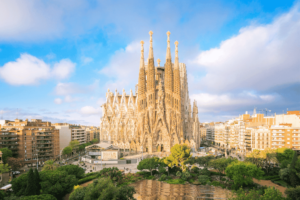
La Sagrada Familia is arguably the most famous landmark in Barcelona and a must-see for any visitor. Designed by the legendary architect Antoni Gaudí, this basilica combines Gothic and Art Nouveau styles in a unique, breathtaking way. Still under construction since 1882, its intricate facades and towering spires make it a symbol of Barcelona’s architectural innovation.
Best Time to Visit: Early morning or late afternoon to avoid crowds and enjoy the lighting.
Nearby Attractions: Hospital de Sant Pau, another of Gaudí’s masterpieces, and the beautiful Avinguda Gaudí promenade.
Park Güell: A Colorful Park with Whimsical Designs
Another of Gaudí’s creations, Park Güell, offers a whimsical escape from the city’s hustle and bustle. The park is filled with colorful mosaics, undulating forms, and playful sculptures, all set against the backdrop of lush gardens and stunning city views.
Best Time to Visit: Early morning or weekdays to avoid the tourist rush.
Nearby Attractions: The Gaudí House Museum, located within the park, and the picturesque Gràcia neighborhood.
Casa Batlló: Modernist Building with a Dragon-Like Facade
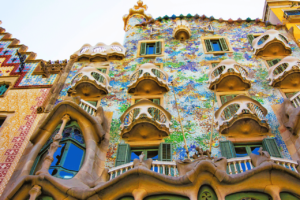
Casa Batlló is a true testament to Gaudí’s genius. Its dragon-like facade, vibrant mosaics, and flowing architectural forms make it one of the most photographed buildings in Barcelona. Inside, the attention to detail and innovative design continue to amaze visitors.
Best Time to Visit: Early morning or late evening for a more peaceful experience.
Nearby Attractions: Casa Milà (La Pedrera), another Gaudí masterpiece just a short walk away, and the upscale shopping street Passeig de Gràcia.
La Rambla: The Lively Main Street of Barcelona
La Rambla is the beating heart of Barcelona, a lively promenade that stretches from Plaça de Catalunya to the Christopher Columbus Monument at Port Vell. It’s lined with cafes, shops, street performers, and markets, offering a vibrant taste of the city’s culture.
Best Time to Visit: Late afternoon to evening when the street comes alive with activity.
Nearby Attractions: The famous Boqueria Market, the historic Liceu Theatre, and the Gothic Quarter.
Gothic Quarter: Narrow Medieval Streets with Hidden Treasures
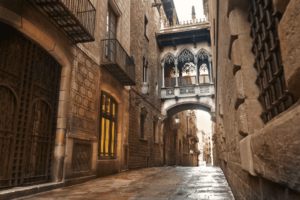
The Gothic Quarter (Barri Gòtic) is a labyrinth of narrow, winding streets that transport you back to medieval times. Here, you can explore ancient Roman ruins, stunning Gothic architecture, and quaint squares filled with cafes and shops.
Best Time to Visit: Morning to explore before it gets crowded.
Nearby Attractions: The Barcelona Cathedral, Plaça Reial, and the Picasso Museum.
Barcelona Guide: Hidden Gems
Bunkers del Carmel: Panoramic Views of the City
For one of the best panoramic views of Barcelona, head to the Bunkers del Carmel. This former anti-aircraft bunker from the Spanish Civil War offers a stunning 360-degree view of the city, making it a perfect spot for sunset.
Tips: Bring a picnic and enjoy a leisurely evening with friends or family.
El Born Cultural Center: Archaeological Site and Cultural Venue
Located in the El Born neighborhood, the El Born Cultural Center showcases the historic ruins of medieval Barcelona. The center offers a fascinating glimpse into the city’s past and hosts various cultural events and exhibitions.
Nearby Attractions: The Santa Maria del Mar church and the trendy shops and cafes of the El Born neighborhood.
Carrer de Blai: Tapas Street in Poble Sec
Carrer de Blai is a vibrant street in the Poble Sec neighborhood known for its tapas bars. Here, you can enjoy a variety of pintxos (small snacks) and drinks at affordable prices, making it a favorite spot for locals and tourists alike.
Best Time to Visit: Evening for the best atmosphere.
Tips: Go on a tapas crawl and try a variety of dishes from different bars.
Things to Do in Barcelona
Itineraries and Experiences
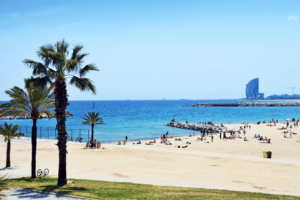
Barcelona offers a variety of activities that cater to all interests. Enjoy a day at the beach along the Mediterranean coast, perfect for sunbathing, swimming, and water sports. For a more active experience, explore the city on a bike tour. These tours offer a unique perspective of Barcelona’s diverse neighborhoods and iconic landmarks.
For more tours use Travel Advice. To create your personalized itinerary in Barcelona use Travel Itinerary.
Local Tours and Excursions
Explore Barcelona’s rich architectural heritage with guided tours of Antoni Gaudí’s masterpieces, including La Sagrada Familia, Park Güell, and Casa Batlló. Food tours are another fantastic way to experience the city, offering a taste of local flavors and culinary traditions.
Seasonal Events and Festivals
Barcelona is home to numerous festivals throughout the year. La Mercè, held in September, is the city’s largest festival, featuring parades, concerts, and fireworks. In April, Sant Jordi’s Day celebrates Catalonia’s patron saint with book and rose exchanges, transforming the city into a vibrant celebration of culture and love.
Food and Dining in Barcelona – Guide
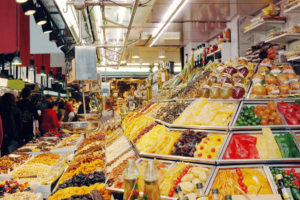
Famous Catalan Dishes
Barcelona’s culinary scene is a reflection of its rich Catalan heritage. Must-try dishes include paella, a flavorful rice dish typically made with seafood; tapas, a variety of small savory dishes; and crema catalana, a creamy dessert similar to crème brûlée.
Best Places to Eat
The city boasts an impressive range of dining options, from Michelin-starred restaurants to charming local eateries. For a luxurious dining experience, try restaurants like Cinc Sentits or ABaC. For a more casual setting, explore local favorites like Bar Cañete or El Xampanyet.
Food Markets and Street Food
Barcelona’s food markets are a paradise for food lovers. La Boqueria, located on La Rambla, offers a vast array of fresh produce, seafood, and prepared foods. Mercat de Sant Antoni is another popular market known for its diverse food stalls and lively atmosphere.
Barcelona Accommodations
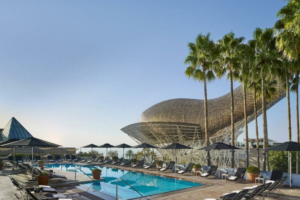
Types of Lodging
Barcelona provides a wide range of accommodation options to suit all budgets and preferences, including hotels, hostels, and vacation rentals.
Recommended Areas to Stay
- Eixample: Known for its modernist architecture and upscale shops.
- Gràcia: A bohemian neighborhood with a village-like atmosphere.
- Barceloneta: Close to the beach, offering a lively seaside experience.
Luxury Options
For a luxurious stay, consider boutique hotels like Hotel Casa Fuster or the elegant Hotel Arts Barcelona. These establishments offer top-notch amenities and services in prime locations.
Budget Options
Travelers on a budget can find affordable accommodations in hostels and guesthouses. Options like Hostel One Ramblas and Fabrizzio’s Petit provide comfortable stays without breaking the bank.
Guide to Transportation in Barcelona
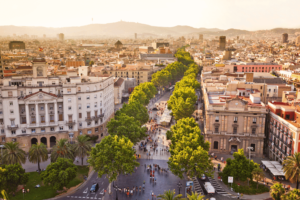
How to Get Around the City
Barcelona boasts a comprehensive and efficient public transportation system. The Metro, operated by Transports Metropolitans de Barcelona (TMB), is the fastest way to navigate the city, with eight lines connecting key areas. Buses offer extensive routes, providing a scenic way to explore. Taxis are plentiful and convenient, while bike rentals are popular for those who prefer a more active way to see the sights.
Tips for Navigating Public Transport
Understanding the TMB system is crucial for smooth travel. Purchase a T10 ticket, which offers 10 rides on the Metro, buses, trams, and even some regional trains. The TMB app provides real-time updates and route planning, making it easier to navigate the city.
Airport and Train Station Information
El Prat Airport, located about 12 km from the city center, is accessible by Aerobus, Metro Line 9, and train. Sants Station is the main train hub, offering high-speed AVE services to major Spanish cities and international destinations .
Shopping in Barcelona
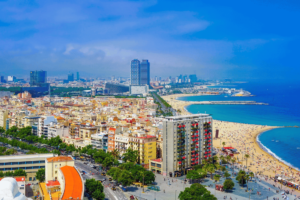
Famous Shopping Districts and Streets
Passeig de Gràcia is Barcelona’s most famous shopping street, lined with luxury boutiques and designer stores. Portal de l’Àngel, a bustling pedestrian street, is perfect for high-street fashion and popular retail brands.
Local Markets and Boutiques
For a unique shopping experience, visit Els Encants Vells, one of Barcelona’s oldest flea markets, offering everything from antiques to clothing. Carrer de Verdi in Gràcia is known for its eclectic mix of local boutiques and artisanal shops.
Souvenirs to Buy
Bring home a piece of Barcelona with local crafts such as mosaic tiles inspired by Gaudí’s works, Cava (Catalan sparkling wine), and traditional Catalan ceramics .
Discover Barcelona: Nightlife and Entertainment
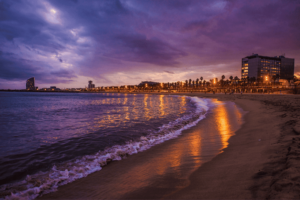
Bars, Clubs, and Nightlife Spots
El Raval is a vibrant neighborhood known for its diverse nightlife, offering trendy bars and eclectic clubs. Poble Nou is another hotspot, featuring converted warehouses that now house some of the city’s most popular nightclubs.
Live Music Venues and Theaters
Experience Barcelona’s rich cultural scene at venues like Palau de la Música Catalana, a stunning concert hall hosting a variety of performances. The Gran Teatre del Liceu on La Rambla is the city’s premier opera house.
Cultural Performances
Don’t miss a traditional flamenco show for an authentic Spanish experience. Contemporary art galleries, such as the MACBA (Museum of Contemporary Art of Barcelona), showcase innovative works by local and international artists .
Practical Information & Tips to Visit Barcelona
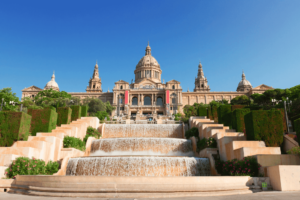
Safety Tips and Emergency Contacts
Barcelona is a safe city, but it’s wise to stay vigilant, especially in crowded areas. Avoid displaying valuables and be aware of your surroundings to prevent pickpocketing. In case of emergencies, dial 112 for immediate assistance. Keep a list of important contacts such as your embassy and local police.
Language and Common Phrases
Catalan and Spanish are the official languages in Barcelona. Learning a few basic phrases can enhance your experience:
- Hello: Hola
- Thank you: Gracias (Spanish), Gràcies (Catalan)
- Please: Por favor (Spanish), Si us plau (Catalan)
- Excuse me: Perdón (Spanish), Perdó (Catalan)
Get Help with Travels Jinn’s Travel Translate: remove all the language barriers with this simple tool that will allow you to communicate in any language!
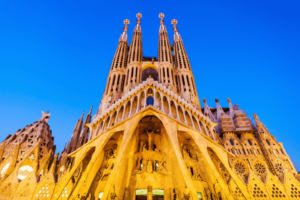
Currency, Tipping, and Payment Methods
Barcelona uses the Euro (€). Credit and debit cards are widely accepted, but carrying some cash is advisable. Tipping is not mandatory but appreciated; rounding up the bill or leaving a 5-10% tip in restaurants is customary.
Best Time to Visit
The best time to visit Barcelona is from May to June and September to October when the weather is pleasant and crowds are manageable. Summers can be hot and crowded, while winters are mild but quieter.
Do you want to discover other unique European cities? Read our 18 Best Cities to visit in Europe.
Day Trips and Excursions from Barcelona
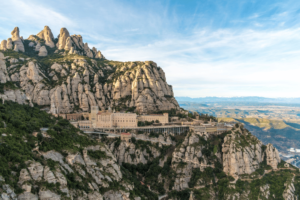
Nearby Towns or Attractions Worth Visiting
- Montserrat: Famous for its stunning mountain range and monastery.
- Sitges: A charming seaside town with beautiful beaches and a lively cultural scene.
- Tarragona: Known for its Roman ruins and historic architecture.
Guided Day Trips and Self-Guided Itineraries
Consider guided tours for a structured experience, especially to Montserrat with its complex trails and cultural sites.
Self-guided itineraries allow more flexibility; for example, you can take a train to Sitges and explore at your own pace, enjoying its beaches and local cuisine.
Customize Your Dream Trip to Barcelona with Travels Jinn
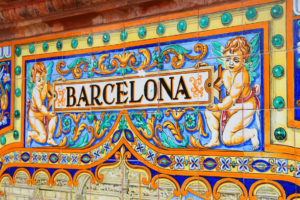
Travel is all about your personal adventure, and with Travels Jinn, crafting your ideal Barcelona getaway has never been easier. Whether you’re seeking luxurious accommodations, reliable car rentals, exciting activities, or insider tips, Travels Jinn has everything you need!
Travels Jinn helps you plan your perfect itinerary, offers comprehensive travel guides, provides translation services, and tracks your expenses. Your Barcelona adventure will be seamless, stress-free, and exactly as you envisioned it!
Start your journey with Travels Jinn today!

